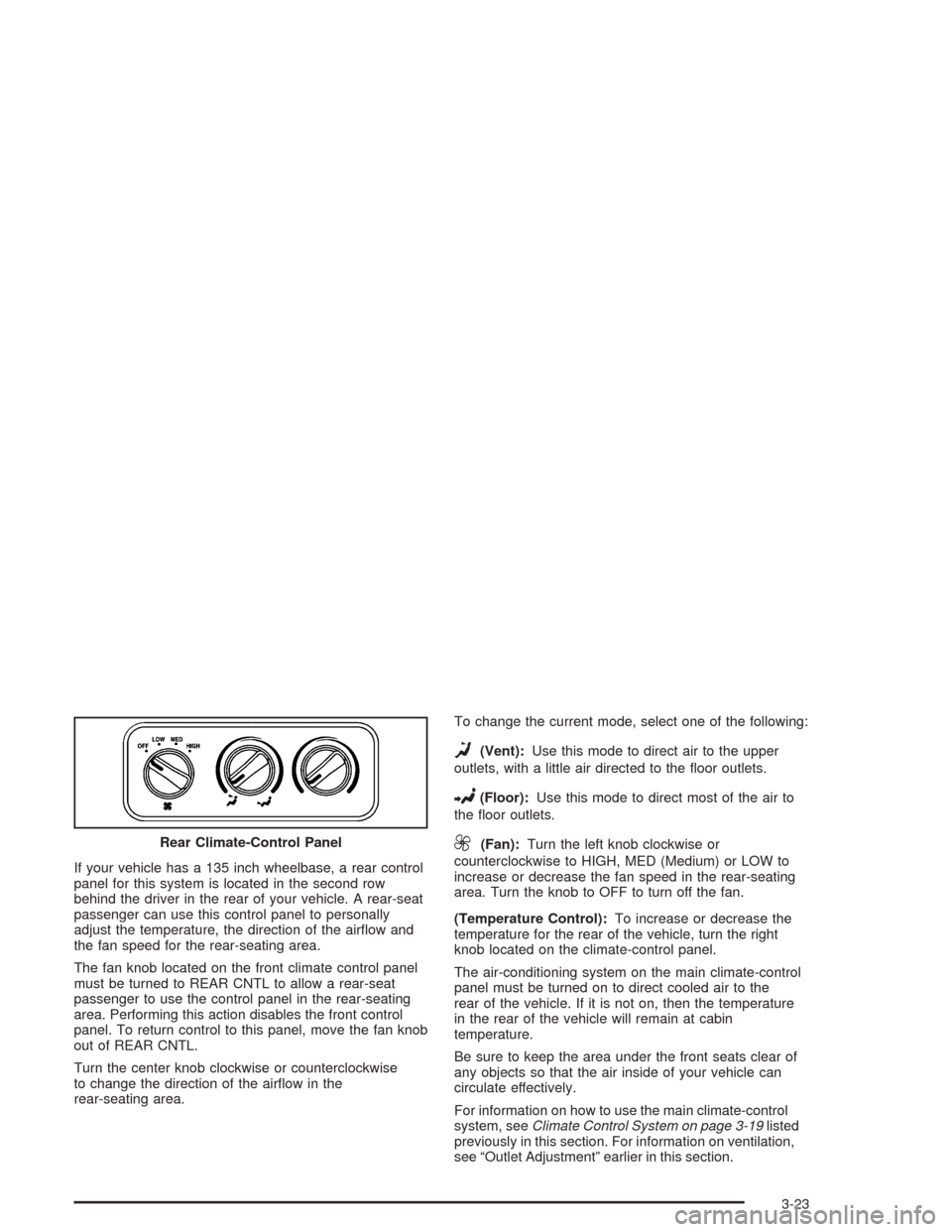Page 147 of 406

If your vehicle has a 135 inch wheelbase, a rear control
panel for this system is located in the second row
behind the driver in the rear of your vehicle. A rear-seat
passenger can use this control panel to personally
adjust the temperature, the direction of the air�ow and
the fan speed for the rear-seating area.
The fan knob located on the front climate control panel
must be turned to REAR CNTL to allow a rear-seat
passenger to use the control panel in the rear-seating
area. Performing this action disables the front control
panel. To return control to this panel, move the fan knob
out of REAR CNTL.
Turn the center knob clockwise or counterclockwise
to change the direction of the air�ow in the
rear-seating area.To change the current mode, select one of the following:
D(Vent):Use this mode to direct air to the upper
outlets, with a little air directed to the �oor outlets.
2(Floor):Use this mode to direct most of the air to
the �oor outlets.
9(Fan):Turn the left knob clockwise or
counterclockwise to HIGH, MED (Medium) or LOW to
increase or decrease the fan speed in the rear-seating
area. Turn the knob to OFF to turn off the fan.
(Temperature Control):To increase or decrease the
temperature for the rear of the vehicle, turn the right
knob located on the climate-control panel.
The air-conditioning system on the main climate-control
panel must be turned on to direct cooled air to the
rear of the vehicle. If it is not on, then the temperature
in the rear of the vehicle will remain at cabin
temperature.
Be sure to keep the area under the front seats clear of
any objects so that the air inside of your vehicle can
circulate effectively.
For information on how to use the main climate-control
system, seeClimate Control System on page 3-19listed
previously in this section. For information on ventilation,
see “Outlet Adjustment” earlier in this section. Rear Climate-Control Panel
3-23
Page 242 of 406
Vehicle Axle Ratio Maximum Trailer Weight GCWR
G2500 Cargo Van 2WD
4300 V6 3.73 4,700 lbs. (2 132 kg) 9,500 lbs. (4 309 kg)
4800 V83.73
4.106,400 lbs. (2 903 kg)
7,400 lbs. (3 357 kg)12,000 lbs. (5 443 kg)
13,000 lbs. (5 897 kg)
5300 V8 3.73 6,600 lbs. (2 994 kg) 12,000 lbs. (5 443 kg)
6000 V83.73
4.108,400 lbs. (3 810 kg)
10,000 lbs. (4 536 kg)14,000 lbs. (6 350 kg)
16,000 lbs. (7 257 kg)
Vehicle Axle Ratio Maximum Trailer Weight GCWR
H2500 Cargo Van AWD
5300 V8 3.73 6,400 lbs. (2 903 kg) 12,000 lbs. (5 443 kg)
Vehicle Axle Ratio Maximum Trailer Weight GCWR
G2500 Cargo Van 2WD Long Wheelbase
4300 V6 3.73 4,500 lbs. (2 041 kg) 10,000 lbs. (4 536 kg)
4800 V83.73
4.106,300 lbs. (2 858 kg)
7,300 lbs. (3 311 kg)12,000 lbs. (5 443 kg)
13,000 lbs. (5 897 kg)
5300 V8 3.73 6,500 lbs. (2 948 kg) 12,000 lbs. (5 443 kg)
6000 V83.73
4.108,200 lbs. (3 719 kg)
10,000 lbs. (4 536 kg)14,000 lbs. (6 350 kg)
16,000 lbs. (7 257 kg)
4-42
Page 243 of 406
Vehicle Axle Ratio Maximum Trailer Weight GCWR
G2500 Passenger Van 2WD Short Wheelbase
6000 V83.73
4.107,900 lbs. (3 583 kg)
9,900 lbs. (4 491 kg)14,000 lbs. (6 350 kg)
16,000 lbs. (7 257 kg)
Vehicle Axle Ratio Maximum Trailer Weight GCWR
G2500 Passenger Van 2WD Long Wheelbase
6000 V83.73
4.107,500 lbs. (3 402 kg)
9,500 lbs. (4 309 kg)14,000 lbs. (6 350 kg)
16,000 lbs. (7 257 kg)
Vehicle Axle Ratio Maximum Trailer Weight GCWR
G3500 Cargo Van 2WD Short Wheelbase
6000 V83.73
4.108,300 lbs. (3 765 kg)
10,000 lbs. (4 536 kg)14,000 lbs. (6 350 kg)
16,000 lbs. (7 257 kg)
Vehicle Axle Ratio Maximum Trailer Weight GCWR
G3500 Cargo Van 2WD Long Wheelbase
6000 V83.73
4.108,100 lbs. (3 674 kg)
10,000 lbs. (4 536 kg)14,000 lbs. (6 350 kg)
16,000 lbs. (7 257 kg)
4-43
Page 244 of 406
Vehicle Axle Ratio Maximum Trailer Weight GCWR
G3500 Passenger Van 2WD Short Wheelbase
6000 V83.73
4.107,800 lbs. (3 538 kg)
9,800 lbs. (4 445 kg)14,000 lbs. (6 350 kg)
16,000 lbs. (7 257 kg)
Vehicle Axle Ratio Maximum Trailer Weight GCWR
G3500 Passenger Van 2WD Long Wheelbase
6000 V83.73
4.107,400 lbs. (3 357 kg)
9,400 lbs. (4 264 kg)14,000 lbs. (6 350 kg)
16,000 lbs. (7 257 kg)
The Gross Combined Weight Rating (GCWR) is the
total allowable weight of the completely loaded vehicle
and trailer including any passengers, cargo equipment
and conversion. The GCWR for your vehicle should not
be exceeded.You can ask your dealer for our trailering information or
advice, or you can write us at the address listed in
your Warranty and Owner Assistance Information
Booklet.
In Canada, write to:
General Motors of Canada Limited
Customer Communication Centre, 163-005
1908 Colonel Sam Drive
Oshawa, Ontario L1H 8P7
4-44
Page 359 of 406
Capacities (cont’d)
ApplicationCapacities
English Metric
Engine Oil With Filter
After re�ll, the level must be rechecked. Add enough engine oil so that the �uid is within the proper operating
range. SeeEngine Oil on page 5-13
VORTEC™ 4300 V6 (Vin W) 4.5 quarts 4.3 L
VORTEC™ 4800 V8 ( Vin V) 6.0 quarts 5.7 L
VORTEC™ 5300 V8 (Vin T) 6.0 quarts 5.7 L
VORTEC™ 6000 V8 (Vin U) 6.0 quarts 5.7 L
Fuel Tank
Standard Tank (Passenger and Cargo) 31.0 gallons 117.3 L
Standard Tank (Cab and Chassis) 33.0 gallons 124.9 L
Optional Tank* (Cab and Chassis) 57.0 gallons 215.7 L
* 159 inch wheelbase or 177 inch wheel base only
Air Conditioning Refrigerant Capacity
Air Conditioning Refrigerant R-134a (Front) 1.8 lbs (0.81 kg)
Air Conditioning Refrigerant R-134a (Front and Rear) 3.1 lbs (1.41 kg)
5-107